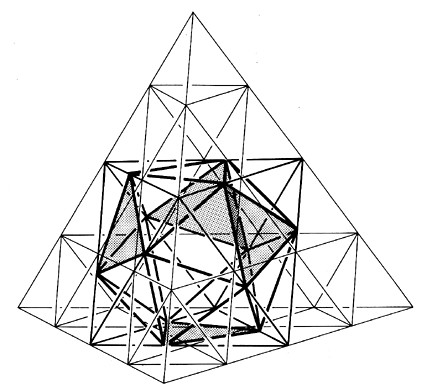The accusation of "math avoidance" comes from those claiming our K-12 maths curriculum (using the UK plural) is too watered down, too diluted with geegaws and gizmos. It's just "toy math".
Whereas I'm sympathetic to the accusation, I do need to ask if it's "math avoidance" to simply bury all the late 20th Century innovations documented in architecture, regarding the relationship of geodesic spheres to the virus and buckyball both.
Is it wise to be so ignorant of this heritage?
Readers of Synergetics already know of the volume 20 VE, which contracts to a volume 18.51 Icosa by Jitterbugging. That's our s-Factor at work i.e. (Svol / Evol) to the -1 i.e. Evol / Svol.
20 * (1 / sFactor) = 18.51...
As seen from the excerpt below, from a Python program, these two volumes come with "S + s3" and "E + e3" expressions for volumetric decompositions.
In this case-sensitive notation, S:s3 == E:e3 == Phi ** 3 i.e. the linear dimensions of s3 are 1/phi those of the S-module, ditto e3 vis-a-vis the E-module.
The S-module has a tetra-volume of pow(phi, -5)/2.
With output:
Whereas I'm sympathetic to the accusation, I do need to ask if it's "math avoidance" to simply bury all the late 20th Century innovations documented in architecture, regarding the relationship of geodesic spheres to the virus and buckyball both.
Is it wise to be so ignorant of this heritage?
Fig. 988.12 Icosahedron Inscribed Within Octahedron: The four-frequency tetrahedron inscribes an internal octahedron within which may be inscribed a skew icosahedron. Of the icosahedron's 20 equiangular triangle faces, four are congruent with the plane of the tetra's faces (and with four external faces of the inscribed octahedron). Four of the icosahedron's other faces are congruent with the remaining four internal faces of the [ octahedron ]. Two-fifths of the icosa faces are congruent with the octa faces. It requires 24 S Quanta Modules to fill in the void between the octa and the icosa.
Readers of Synergetics already know of the volume 20 VE, which contracts to a volume 18.51 Icosa by Jitterbugging. That's our s-Factor at work i.e. (Svol / Evol) to the -1 i.e. Evol / Svol.
20 * (1 / sFactor) = 18.51...
As seen from the excerpt below, from a Python program, these two volumes come with "S + s3" and "E + e3" expressions for volumetric decompositions.
In this case-sensitive notation, S:s3 == E:e3 == Phi ** 3 i.e. the linear dimensions of s3 are 1/phi those of the S-module, ditto e3 vis-a-vis the E-module.
The S-module has a tetra-volume of pow(phi, -5)/2.
print("VE: ", 20, 420 * Svol + 100 * s3)
print("Icosa: ", 20 * sFactor ** 1, 420 * Evol + 100 * e3)
With output:
VE: 20 19.99999999999996 Icosa: 18.5122958682192 18.512295868219162
Another Icosa-to-Cubocta relationship involves not Jitterbugging, but keeping the faces flush, eight of them, though only partially overlapping, as shown in the figure below:
Fig. 988.00 Polyhedral Evolution: S Quanta Module:
Comparisons of skew polyhedra.
We could call this a "skew" relationship and applying 1/sFactor twice to the 18.51 icosahedron takes use to what Koski affectionately calls the "Small Guy" cubocta, of volume ~15.86065.
What is it's frequency, assuming Icosa edges = 2? Recalled 20 * F**3 is our formula:
print("Small Guy edge:", 2 * pow(sFactor ** -3, 1/3))
Output:
Small Guy edge: 1.8512295868219202
What's interesting about that number, a linear dimension, is that it's 1/10th the volume of the jitterbugged icosahedron's. The differences in the ending digits above have merely to do with floating point error margins.
So what is the volume of the Icosa within the volume 4 Octa of Figure 988.12?
Clearly it's 4 - 24 * Svol or 4 - 24 * (pow(phi, -5)/2) = ~2.917961.
>>> Svol = pow(phi, -5)/2 >>> s3 = Svol * pow(phi, -3) >>> 60 * Svol + 20 * s3 # S + s3 form 2.9179606750063085
Applying the reciprocal of the sFactor twice more, to this tiny Octahedron-inscribed icosahedron, nets us the volume of its "skew mate": the volume 2.5 cuboctahedron, i.e. 1/8 the volume of the cuboctahedron of volume 20, faces flush with the same Octa of volume 4.
>>> baby 2.9179606750063085 >>> baby * (1/sfactor) * (1/sfactor) 2.5000000000000107

